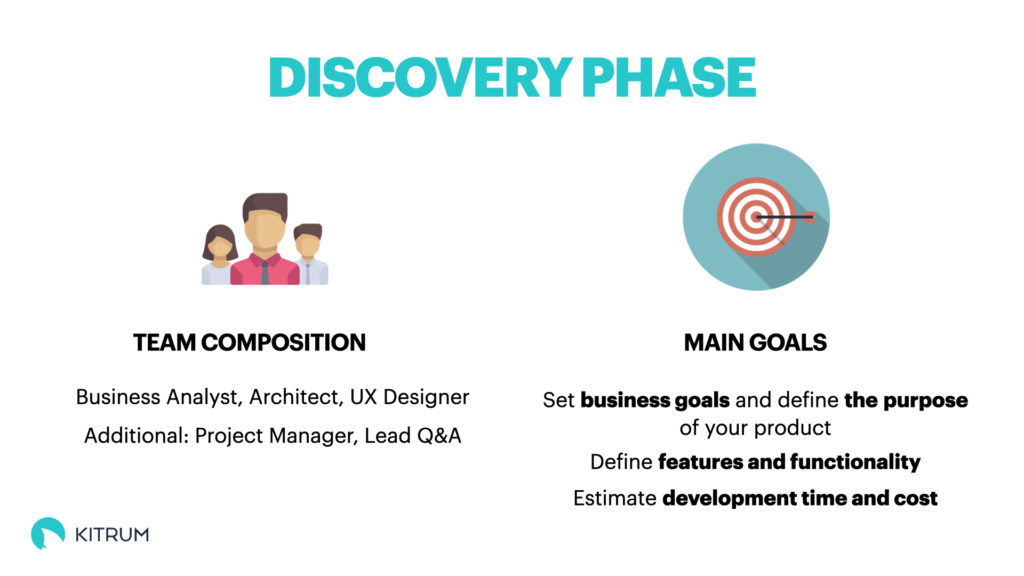How the Discovery Phase Can Help to Build a Successful Project, Avoid Delays and Overspend
The discovery phase helps bring your concept to real-life, considering human resources, technical requirements, financial spending, and what profit you will receive. You will receive a tested product with real customers and an estimation of how much value your product will bring you – either one million or ten.
Discovery phase composition
Usually, the projects consist of initiation, planning, execution, control, and closure phases. The discovery phase should be performed during the initiation and planning phases, connecting those two.
The discovery phase is composed of pre-discovery and discovery itself. If the team uses an Agile methodology, those phases are executed during the first sprint. That is vital for building an understanding between the client and developers.
You should ensure having all the necessary information before starting the actual discovery. Your business goals are set, your service owner or central point of contact is defined, your project manager has all the necessary documents concerning the project, and your approximate budget is set. The finalization of the quote will be achieved during the discovery phase.
The duration of the discovery phase may vary from several days to several weeks or months, which is defined by the size and complexity of the project.
Phases of Discovery process
Discovery starts with defining the stakeholders who participate in building or using the product. Product owners, inverters, developers, administrators, and final users are among them.
The next step is to set the business goal and define the purpose of your solution. It will help determine a problem that may drag the process of its implementation within the discovery phase, thus allowing to come up with the idea of how to solve it at the start. Furthermore, at this point, you should know what KPI to use to define the success of your project. It will help your team find the right product development trajectory and what it should aim for.
Defining your target audience and creating the user journey is a part of the Discovery phase. Here, in KitRUM, we had a client with a fintech project who applied to us for the discovery, as he wasn’t sure of his target audience. He had an idea just of one user image who could be interested in his project. After the Discovery, we came up with three more audiences and a vision of how he could develop his idea considering new potential customers. It helped to define technical solutions and marketing strategies.
If you have any research, surveys, or user interviews concerning your product, provide them to a business analyst from your discovery team so that he could use them in his work. It’s also essential to research competitors and the niche you work in to determine what obstacles they had while the project is out, what technologies they use, and what target audience they reach. Based on this data, you can create a list of software requirement specifications.
One of the main goals of the discovery phase is to estimate the time and costs needed to develop the product. This phase is realized through features estimation. It helps to learn your functions more accurately, understand what values they bring to your client and your business, form a development team and management, and understand the sequence and priority of each function. You will receive a clear roadmap with the main tasks, risks, requirements, timelines, and budgets. The timeline is realistic but still approximate. During the process, you can figure out you need new functionality due to changes in the market, changes in legislation, or other issues. It can happen so that your competitor releases the product before you with the same functionality as with one of our clients.
As the project was still in the discovery phase, we managed to reorganize it and, based on the research, target the other audience than his opponent. Instead of aiming at the B2C market, we approached B2B. It brought more business value, but we also discovered several convenient features for this market, which helped make the idea more scalable. Though it took a long time, prior work on the process and feature estimation allowed us to develop a new idea. We created the MVP, which is common practice for the Discovery phase. Even with minimal functionality, the product appeared to be a helpful tool for businesses dealing with logistics and gained investments, which paid for the development of the final product.
As you can see, hiring the right specialist, flexible and knowledgeable within your sphere, is a key to the successful discovery phase. Let’s define the composition of professionals you need for meaningful work.

Discovery team and responsibilities of each member
People are one of the keys to the success of your project. The better they understand the domain, your goals, and the product, the faster they will manage their tasks and build a precise plan of work. It’s essential to structure your team with the necessary specialists. Usually, it consists of a Business Analyst, Architect, and UX Designer. Additionally, you may consider the Project manager and Lead Q&A. as a part of your team if a project is extensive and requires careful management and continuous testing for MVP.
Let’s figure out what responsibilities each discovery team member is fulfilling. It will help you precisely understand which processes are performed within the discovery phase.
A business analyst plays a core role in the success of your project once the final product is ready for release. To make it successful, he should know all ins and outs of the project. That’s why he is deeply involved in the whole lifecycle. His primary responsibilities are:
– gather and document requirements to share them with the team
– shape a precise project vision through user stories and according to the Product Owner’s goals
– study the market for competitors and define references
– build a business model in cooperation with the Product Owner
– work on prototype together with UX designer
– list the tasks within the project together with the Product Owner
– take part in forming the budget and deadlines.
The Architect manages everything concerning the technical side of the project. His tasks are the following:
– detail the tech process if the implementation is based on the requirements of the Business Owner
– figure out the best implementation process with the Business analyst
– set the scope of principles, rules, and goals for the development team to follow during the implementation phase
– structure the project by dividing it into components and layers
– create logical and physical topology diagrams of the project
– define project terminology together with Business Analyst for the team to talk and write code with mutual understanding
– make tech research on the systems integrated into the project
– figure out complex engineering issues that may result in high risk
– analyze technical risks which may occur
– estimate the project and set deadlines
A UX Designer is in charge of how suitable the product is for your users in terms of use. The user experience is usually built not only on users’ habits to create familiar and intuitive solutions but also on current trends in design. Through the discovery phase, his role is the following:
– create a prototype to understand the product’s function and image
– develop a UI Kit
– analyze the habits of the audience
– make UX research
– take part in estimating the project and deadlines
A Project manager is responsible for organizing the work of the whole team. His responsibilities are:
– define the Discovery Phase stages
– manage the process and track the workflow to meet their deadlines
– define organizational risks
– take part in estimating the project and deadlines
The Lead QA will create a test plan, which will help to define the requirements for product responsiveness, supported devices, etc. QA will also help clarify errors in the early stages, which is less costly than fixing the whole code once it is written. His role within a team is the following:
– develop a test strategy
– test prototypes and requirements
– take part in estimating the project and deadlines
The whole Discovery team works within T–shaped responsibilities structure, which means that the knowledge and understanding of the project go beyond their specific field. It helps to move the project forward.
The outcome of the Discovery phase

Finalization of the Discovery phase will result in several conclusions and a product UX prototype with a minimal representation of the product’s interface and features. One of the primary documents you will be the Software requirements specification, which contains the project’s full description, feature set, recommended tech stack, and architecture outline.
You will also receive recommendations on the team composition, development budget, and approximate deadlines. Last but not least Discovery conclusion will ensure that the project team understands your project and that the final product will meet your requirements and needs.
Finalizing the discovery phase, make sure you covered all the issues for switching to the project development and implementations. Go through the checklist and answer the following questions:
– all the requirements are taken into account
– resources engaged in the project are set
– resources are accurately allocated
– the timeline is drawn with consideration of unexpected occurrences
– budget is estimated and verified
– the roadmap of product implementation is created
– the dashboard for monitoring the progress is developed
– relevant contacts are signed
If you gave positive answers to all those points, you have successfully fulfilled the development phase and are ready to move to software development.



